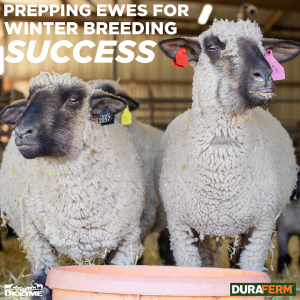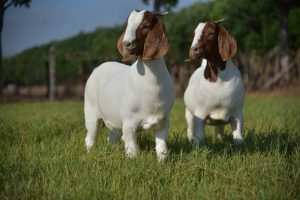
Raising goats has become quite the trend. Just because everyone is doing it doesn’t mean everyone has to use the same management style. Three primary reproductive options are commonly used for breeding goats: natural breeding, artificial insemination and embryo transfer.
Every operation has its own set of goals and management practices that best suit its resources. That’s why the DuraFerm® team created this educational resource. We want to create awareness about the reproductive choices and the advantages when it comes to breeding goats. Then, you can make the best decision for your respective operation.
DuraFerm nutrition supplements ensure your animals receive optimal digestive health and nutrition. The result? Maximized performance at every production stage. We specifically formulate our products for both goats and sheep, so each species gets the nutrients they require and deserve. Maximize your reproductive performance and herd health with DuraFerm, regardless of the breeding method you choose for your does.
Three Reproductive Options for Breeding Goats
Natural Breeding
Natural breeding involves allowing the buck, a male goat, and the doe, a female goat, to mate directly or naturally. This traditional method is straightforward, requires minimal equipment or labor and is generally cost-effective.
Natural breeding is also efficient for small herds where goats can live together, as the buck recognizes when the doe is in estrus (heat) and breeds her naturally. However, this method can be challenging for large herds or breeders wanting to control specific genetic traits. It offers less precision in lineage tracking when using multiple bucks and genetic selection.
Artificial Insemination
Artificial Insemination (AI) allows for selective breeding and genetic diversity without requiring bucks to be physically present. With AI, semen from a genetically superior buck is collected, stored and introduced to a doe in heat.
This method gives breeders access to high-quality genetic material, even from distant locations. Goat AI can improve herd genetics, optimize milk production and enhance desirable traits. However, it requires expertise, proper timing and specialized equipment, making it more labor-intensive and costly than natural breeding.
Embryo Transfer
Embryo Transfer (E.T.) is the most advanced reproductive technique. E.T. involves fertilizing a donor doe with high genetic value and then transferring the embryos to the recipient does. This method enables the production of multiple offspring from a single genetically superior doe in one breeding season, significantly enhancing herd genetics and reproductive output.
Embryo transfer in goats is expensive and requires skilled veterinary support, making it practical mostly for high-value goats or breeders focusing on rapid genetic improvement.
DuraFerm Can Help
When it comes to the time for breeding goats, you have choices – natural, AI or E.T. One choice you don’t have to make is to keep your does on a good nutritional program, before breeding and through goat gestation.
DuraFerm is a line of nutritional supplements for sheep and goats that supports optimal digestion and nutrition for maximized performance at every production stage. For goats, we offer two products designed to help strengthen your stock and support reproductive success.
DuraFerm® Goat Concept•Aid®
DuraFerm Goat Concept•Aid is a free-choice vitamin and mineral supplement for goats to support reproductive success. Goat Concept•Aid contains AO-Biotics® Amaferm®, a prebiotic research proven to enhance digestibility. It also includes high levels of vitamin E for reproductive tract repair and supports embryo production and conception using organic trace minerals. It comes in a 50-pound bag.
DuraFerm® Goat Concept•Aid® Protein Tub
DuraFerm Goat Concept•Aid Protein Tub is a 50-pound protein tub with vitamins and minerals for goats designed to support reproductive success. It also contains Amaferm, a prebiotic research-proven to enhance digestibility. The 20% natural protein tub contains the Concept•Aid goat mineral package and supports embryo production and conception using organic trace minerals and high levels of vitamin E.
We recommend feeding both products to the entire herd 30 days before kidding through at least 30 days post-breeding. They can be fed year-round to both does and bucks, and for increased protein at kidding, switch between the loose mineral to the tub.
More about DuraFerm for Goat Gestation
The average gestation length (length of pregnancy) of a goat is 150 days or roughly five months. DuraFerm has created a Goat Gestation Calculator to make it simple for you to calculate the gestation length of your does.
The Final Word
Breeding goats should be a fun experience! You can start small with natural breeding and over time, work your way up to flushing embryos on a superior donor doe, using embryo transfer. Just remember take care of your does, and your does will take care of your kids!
Furthermore, this is just one resource. We might know a thing or two about nutrition, but we are not trained animal caretakers. We encourage you to establish a relationship with your veterinarian.
Whether you’ve been breeding goats for 10 years or 10 months, you will always have issues that require medical attention. In which case, your veterinarian will already have insights into your herd. This understanding of your operation will make their job of caring for your animals easier. In short, having a trusted relationship with your vet is the best way to support your herd.
Get your DuraFerm Today
Get your breeding goats healthy with DuraFerm Goat Concept•Aid products powered by AO-Biotics Amaferm. Purchase DuraFerm through the extensive BioZyme dealer network. Locate a dealer near you today.
Don’t forget to use our Goat Gestation Calculator. This handy guide can help you with all your goat breeding calculations.
You can also learn more about DuraFerm from our educational blog series or by signing up for our newsletter.

